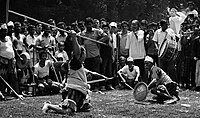Lathi khela
 Lathi khela competition in Bangladesh | |
| Focus | Stick fighting |
|---|---|
| Famous practitioners | Pulin Behari Das |
| Olympic sport | No |
| Meaning | Staffplay |
| Part ofa serieson the |
| Culture of Bengal |
|---|
 |
| History |
| Cuisine |
Lathi khela(Bengali:লাঠি খেলা) is a traditional Bengali martial art[1][2]– a kind ofstick fightingpracticed inBangladesh.[3]A practitioner is known as alathial.[4]Lathi khela originated from theBengalregion inIndian subcontinent.
Etymology
[edit]The wordlathiis theBengaliword meaning stick, whilekhelameans a sport or game. Therefore,lathi khelatranslates as a game of sticks.[5][6]
Instruments
[edit]The lathi is normally made of themale bambooand sometimes bound at short intervals with iron rings. A typical lathi measures 6 to 8 feet (2 to 2.4 m). Some, called bari, are shorter and may be wielded like a baton or bludgeon. In the past, sticks could be paired with shields, as can still be seen innori bari(mock stick-fight) demonstrations.
History
[edit]Rich farmers and other eminent people hiredlathialfor security and as a symbol of their power. Duels were used as a way to protect or take land and other possessions. Aproverbin some South Asian languages is "whoever wields the lathi keeps thebuffalo".Zamindars(feudal lords) sent groups oflathialto forcefully collect taxes from villagers. Lathi training was at one time included in theBratacharisystem of education.[7]
Although lathi is practised in Indian and Bangladeshi villages, urbanization has led to its decline as a ruralmartial artin recent decades. Until 1989, an annual nationwide lathi khela convention was held in Kushtia, Bangladesh, where troupes from all over the country took part.[4]Due to the drop in practitioners and spectators, the convention is now held once every three years. Even in the districts where lathi troupes once flourished, only several now remain. Today, lathi khela is most often seen during festivals and weddings.[8]Matches are held inWest Bengalfor certain puja rituals, and a similar sport calledchamdiis played during Eid in North Bengal.
Practice
[edit]Lathial group performed acts like Baoi Jhak (group fight), Nori Bari (mock fight with sticks), Fala Khela and Dao Khela (mock fight with sharp weapons) and Chhuri dance to music, in the presence of hundreds. These groups may learn the arts ofdao khela(machete fighting) andfara khela(sword fighting), both of which are preserved today in the form of mock-fights. Matches are generally one-on-one, but the art includes mock-group fights orbaoi jhak.In lathi the centre of energy is the heartchakra,and practitioners fight in a more upright position.[7][8]
See also
[edit]References
[edit]- ^Khan, Saleque (2007).Performing the (imagi)nation: A Bangladesh Mise-en-scene.New York University. p. 237.ISBN978-0-549-09962-8.
- ^Ahmed, Sharif Uddin (1999).Sylhet: History and Heritage.Bangladesh Itihas Samiti.ISBN978-984-31-0478-6.
- ^"Lathi Khela to celebrate Tangail Free Day".The Daily Star.13 December 2011.
- ^ab"'Lathi khela' at Charukala ".bangladesh2day.com.27 December 2008. Archived fromthe originalon 9 May 2015.Retrieved9 June2013.
- ^"Three-day cultural fair ended in Barisal".New Age.26 February 2012. Archived fromthe originalon 12 November 2013.Retrieved9 June2013.
- ^Islam, Sirajul (2012)."Lathial".InIslam, Sirajul;Jamal, Ahmed A. (eds.).Banglapedia: National Encyclopedia of Bangladesh(Second ed.).Asiatic Society of Bangladesh.
- ^abঈদ উৎসবের নানা রং.Prothom Alo(in Bengali). 2 August 2013. Archived fromthe originalon 9 August 2013.
- ^ab"Lathi Khela to celebrate Tangail Free Day".Dhaka Mirror.13 December 2011. Archived fromthe originalon 29 October 2013.Retrieved9 June2013.
